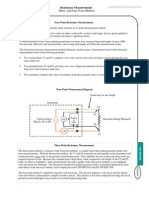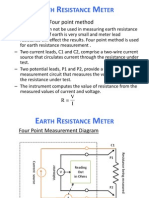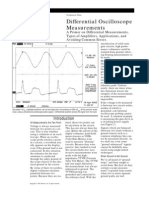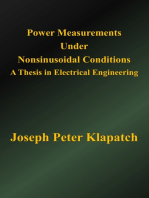Ground Test
Ground Test
Uploaded by
Hemendra JaniCopyright:
Available Formats
Ground Test
Ground Test
Uploaded by
Hemendra JaniCopyright
Available Formats
Share this document
Did you find this document useful?
Is this content inappropriate?
Copyright:
Available Formats
Ground Test
Ground Test
Uploaded by
Hemendra JaniCopyright:
Available Formats
4PTRES
Resistance Measurements Three- and Four-Point Method
Copyright 2002 Kilowatt Classroom, LLC.
Four-Point Resistance Measurements Ohmmeter measurements are normally made with just a two-point measurement method.
Test Methods
However, when measuring very low values of ohms, in the milli- or micro-ohm range, the two-point method is not satisfactory because test lead resistance becomes a significant factor. A similar problem occurs when making ground mat resistance tests, because long lead lengths of up to 1000 feet, are used. Here also, the lead resistance, due to long lead length, will affect the measurement results. The four-point resistance measurement method eliminates lead resistance. Instruments based on the four-point measurement work on the following principle: Two current leads, C1 and C2, comprise a two-wire current source that circulates current through the resistance under test. Two potential leads, P1 and P2, provide a two-wire voltage measurement circuit that measures the voltage drop across the resistance under test. The instrument computes the value of resistance from the measured values of current and voltage.
Four-Point Measurement Diagram Leads may be any length. Instrument C1 P1 Current Source May be AC or DC.
VM Readout in Ohms
Resistance Being Measured P2
AM
C2
Three-Point Resistance Measurements The three-point method, a variation of the four-point method, is usually used when making ground (earth) resistance measurements. With the three-point method, the C1 and P1 terminals are tied together at the instrument and connected with a short lead to the ground system being tested. This simplifies the test in that only three leads are required instead of four. Because this common lead is kept short, when compared to the length of the C2 and P2 leads, its effect is negligible. Some ground testers are only capable of the three-point method, so are equipped with only three test terminals. The three-point method for ground system testing is considered adequate by most individuals in the electrical industry. Sheet 1 The four-point method is required to measure soil resistivity. This process requires a soil cup of specific dimensions into which a representative sample of earth is placed. This process is not often employed in testing electrical ground systems although it may be part of an initial engineering study.
GTEST1
Ground Testing Methods
Purpose
Copyright 2003 Kilowatt Classroom, LLC.
The purpose of electrical ground testing is to determine the effectiveness of the grounding medium with respect to true earth. Most electrical systems do not rely on the earth to carry load current (this is done by the system conductors) but the earth may provide the return path for fault currents, and for safety, all electrical equipment frames are connected to ground. The resistivity of the earth is usually negligible because there so much of it available to carry current. The limiting factor in electrical grounding systems is how well the grounding electrodes contact the earth, which is known as the soil / ground rod interface. This interface resistance component, along with the resistance of the grounding conductors and the connections, must be measured by the ground test. In general, the lower the ground resistance, the safer the system is considered to be. There are different regulations which set forth the maximum allowable ground resistance, for example: the National Electrical Code specifies 25 ohms or less; MSHA is more stringent, requiring the ground to be 4 ohms or better; electric utilities construct their ground systems so that the resistance at a large station will be no more than a few tenths of one ohm. Grounding methods and techniques for ground system improvement will be covered in a future article.
Ground Testing
Fall-of-Potential Instrument Characteristics To avoid errors due to galvanic currents in the earth, most ground test instruments use an AC current source. A frequency other than 60 hertz is used to eliminate the possibility of interference with stray 60 hertz currents flowing through the earth. The TPI instrument pictured at left uses 575 Hz @ less than 50 volts. A three- or four-point measurement technique is utilized to eliminate the effect of lead length. The test procedure, known as the Fall-of-Potential Method, is described on the following page.
TPI MFT5010 Multi -Function Tester A Three-Point Fall-of Potential Instrument
Clamp-On Instrument Characteristics The clamp -on ground test instrument is a relatively new concept which is particularly well suited for testing the effectiveness of individual equipment grounding conductors that are connected to an existing ground grid. Clamp -on type ground testers are simple and easy-to-use. The instrument injects a current pulse into the ground conductor and calculates the value of the ground conductor resistance from the current pulse amplitude. Some instruments can store the result of a number of readings which simplifies field record keeping. Calibration loop is included with instrument. Clamp-On Type Ground Tester Shown with calibration loop
Sheet 2
GTEST2
Ground Testing Three-Point Fall-of-Potential Test Procedure
Copyright 2003 Kilowatt Classroom, LLC.
Ground Test Procedure Refer to Diagram and Example Graph on the Following Page. The instrument connections shown on the following page are for a three-point instrument, so C1 and P1 are common on the instrument and only three test leads are used. To use a four-point instrument, simply tie the C1and P1 leads together (most four-point instruments have a removable shorting link between the C1 and P1 terminals for this purpose). AC current of a non-standard frequency is usually used for ground testing to minimize the effect of galvanic (DC) currents as well as 60 Hz fundamental and harmonic currents which are present in the earth. The TPI 5010 Multifunction tester detailed in this article produces a 50 volt, 575 Hz test signal. In the Fall-of-Potential Method, two small ground rods - often referred to as ground spikes or probes - about 16 long are utilized. These probes are pushed or driven into the earth far enough to make good contact with the earth ( 8 - 12 is usually adequate). One of these probes, referred to as the remote current probe, is used to inject the test current into the earth and is placed some distance (often 100 ) away from the grounding medium being tested . The second probe, known as the potential probe, is inserted at intervals within the current path and measures the voltage drop produced by the test current flowing through the resistance of the earth. In the example shown on the following page, the remote current probe C2 is located at a distance of 100 feet from the ground system being tested. The P2 potential probe is taken out toward the remote current probe C2 and driven into the earth at ten-foot increments. Based on empirical data (data determined by experiment and observation rather than being scientifically derived), the ohmic value measured at 62% of the distance from the ground-under-test to the remote current probe, is taken as the system ground resistance. The remote current probe must be placed out of the influence of the field of the ground system under test. With all but the largest ground systems, a spacing of 100 feet between the ground-under-test and the remote current electrode is adequate. With adequate spacing between electrodes exists, a plateau will be developed on the test graph. Note: A remote current probe distance of less than 100 feet may be adequate on small ground systems. When making a test where sufficient spacing exists, the instrument will read zero or very near zero when the P2 potential probe is placed near the ground-under-test. As the electrode is moved out toward the remote electrode, a plateau will be reached where a number of readings are approximately the same value (the actual ground resistance is that which is measured at 62% of the distance between the ground mat being tested and the remote current electrode). Finally as the potential probe approaches the remote current electrode, the resistance reading will rise dramatically. The electrical fields associated with the ground grid and the remote electrode are illustrated on Sheet 5. An actual ground test is detailed on Sheet 6 and a sample Ground Test Form is provided on Sheet 7.
Ground Testing
Short Cut Method It is not absolutely necessary to make a number of measurements as described above and to construct a graph of the readings. We recommend this as it provides valuable data for future reference and, once you are set-up, it takes only a few minutes to take a series of readings. However, the short cut method described here determines the ground resistance value and verifies sufficient electrode spacing - and it does save time . Connect the instrument P1/C1 lead to the ground system being tested with a short conductor. Locate the remote current electrode C2 at distance of 100 feet from the ground grid being tested. Place the P2 potential probe at 62 feet from the ground grid being tested and measure the ground resistance. Move the P2 potential probe 10 to either side of the 62 point (this would be at 52 and 72 from the ground grid) and take readings at each of these points. If the readings at these two points are essentially the same as that taken at the 62 point, a measurement plateau exists and the 62 reading is valid. Sheet 3
GTEST3
Ground Testing Three-Point Fall-of-Potential Method
Copyright 2003 Kilowatt Classroom, LLC.
Instrument Set-Up
Ground Testing
Ground Mat Under Test
Yellow arrow indicates P2 potential probe @ 62 feet. Potential probe taken out at 10 foot increments.
Keep this lead as short as possible.
Blue indicates return current path through earth.
T1 T2 (C1 / P1) (P2) T3 (C2)
TPI 5010 Multifunction Tester
Digital Display FCN SW
Ground Tester
Remote current probe C2 @ 100
Test Current Path Test Current (575 Hz ) flows from instrument T3 to remote current probe C2 on the red lead. Test Current flows from remote current probe C2 back through the earth to the ground being tested as shown by dashed blue line. Test current flows out of ground grid back to instrument T1 on the short green lead. Black potential lead P1 is connected to instrument T2 and is taken out at 10 increments. It measures voltage drop produced by the test current flowing through the earth. (P1 to P2 potential.)
Select Earth ( RE )
A Note on Instrument Labeling Conventions Most Ground Testers are single-function units and the test terminals are referred to as C1/P1, P2 & C2, as shown in parenthesis in the diagram above. The test leads carry the same designations. The TPI tester is a multifunction tester and uses the terminal designations T1, T2, & T3. The corresponding lead designations are E (Earth), S & H.
Sample Ground Resistance Plot Remote current electrode C2 @ 100 feet. Potential probe P1 taken out at 10 foot increments. 10 9
Insufficient electrode spacing has no plateau. Resistance in Ohms 7 2 3 4 5 6 8
Sufficient electrode spacing has plateau. 1
Ohms @ 62% of distance = 3.3 ohms Sheet 4
10
20
30
40
50 Distance in Feet
60
70
80
90
100
GTEST4
Ground Testing Equal-Potential Planes
The Existence of Equal-Potential Planes
Copyright 2003 Kilowatt Classroom, LLC.
When current flows through the earth from a remote test electrode (in the case of a ground test) or remote fault, the voltage drop which results from the flow of current through the resistance of the earth can be illustrated by equal-potential planes. The equal-potential planes are represented in the dashed lines in drawings below where the spacing between concentric lines represents some fixed value of voltage. The concentration of the voltage surrounding a grounding element is greatest immediately adjacent to that ground. This is shown by the close proximity of lines at the point where the current enters the earth and again at the point where the current leaves the earth and returns to the station ground mat. In order to achieve a proper test using the Fall-of-Potential Ground Test Method, sufficient spacing must exist between the station ground mat being tested and the remote current electrode such that the equal-potential lines do not overlap. As shown by the black line in the Sample Plot on the previous page, adequate electrode spacing will result in the occurrence of a plateau on the resistance plot. This plateau must exist at 62% of the distance between the ground mat and the remote electrode for the test to be valid. Insufficient spacing results in an overlap of these equal-potential planes, as illustrated at the bottom of this page and by the red line on the Sample Plot on the previous page. See the Safety Note on Sheet 6 for information on the hazards of Step and Touch-Potentials.
Ground Testing
Station Ground Mat Current leaves the earth and returns to the source.
Remote Current Electrode or Remote Fault
Representation of Equal-Potential Planes Showing adequate spacing of electrodes
Ground Mat
Remote Current Electrode
Sheet 5
Representation of Equal-Potential Planes Showing inadequate spacing between the established ground and remote test electrode.
GTEST5
Ground Testing Actual Field Test
Copyright 2003 Kilowatt Classroom, LLC.
This actual ground test was conducted on a pad-mount transformer in a rural mountain area. The single-phase transformer is supplied by a 12470/7200 volt grounded wye primary and the transformer is grounded by its own ground rod as well as being tied to the system neutral which is grounded at multiple points along the line. The distribution line is overhead with just the dip to the transformer being underground.
Ground Testing
Setting-Up the Ground Tester Red arrow shows location of C2 probe. Ground Test Data Remote Current Probe C2 @ 100 Feet P2 Distance from Transformer in Feet 10 20 30 40 50 60 62* 70 80 90 100 Instrument Reading in Ohms 1.83 3.59 3.85 3.95 4.0 4.25 4.3 4.5 5.4 7.3 25.02
TPI MFT5010 Instrument Showing the 50 foot reading of 4.0 Ohms.
Test Procedure Terminal T1 of the TPI 5010 tester was connected to the transformer case ground with a short green lead. The remote Current Probe C2 was driven in the ground at a location 100 feet from the transformer and connected to Terminal T3 of the instrument with the red test lead. Terminal T2 of the tester was connected, using the 100 black lead, to the P2 potential probe. This ground stake was inserted into the ground at 10 intervals and a resistance measurement was made at each location and recorded in the table at the left. The relatively constant readings in the 4 ohm range between 40 and 70 feet is a definite plateau that indicates sufficient lead spacing. The initial readings close to the transformer are lower, and there is a pronounced tip-up as the P2 probe approaches the remote current electrode C2. The measured ground resistance at 62 feet (62% of the distance) was 4.3 ohms and is taken as the system ground resistance. This is an excellent value for this type of an installation.
* Actual Ground resistance.
Safety Note - Possible Existence of Hazardous Step and Touch Potentials It is recommended that rubber gloves be worn when driving the ground rods and connecting the instrument leads. The possibility of a system fault occurring at the time the ground test is being conducted is extremely remote. However, such a fault could result in enough current flow through the earth to cause a possible hazardous step potential between a probe and where the electrician is standing, or hazardous touch potential between the probes and the system ground. The larger the system, in terms of available fault current, the greater the possible risk.
Sheet 6
Ohms
You might also like
- Earth Loop Impedance Tests PDFDocument20 pagesEarth Loop Impedance Tests PDFRajendra Prasad Shukla67% (3)
- It Is Quite Another Electricity: Transmitting by One Wire and Without GroundingFrom EverandIt Is Quite Another Electricity: Transmitting by One Wire and Without GroundingRating: 4.5 out of 5 stars4.5/5 (2)
- Earth Resistance TesterDocument8 pagesEarth Resistance TesterAnonymous vcadX45TD7No ratings yet
- Methods of Earth Resistance Testing (Part-2) - Electrical Notes & ArticlesDocument8 pagesMethods of Earth Resistance Testing (Part-2) - Electrical Notes & ArticlesVenkataramanan SNo ratings yet
- 4 Important Methods of Ground Resistance TestingDocument5 pages4 Important Methods of Ground Resistance TestingAbdul Mohid Sheikh100% (1)
- Earthing Testing MethodsDocument3 pagesEarthing Testing Methodsusama hanifNo ratings yet
- Methods of Earth Resistance TestingDocument6 pagesMethods of Earth Resistance Testingsubu100% (1)
- Ground TestingDocument31 pagesGround TestingabdulkadhirNo ratings yet
- Three-And Four-Point Method: Resistance MeasurementsDocument8 pagesThree-And Four-Point Method: Resistance MeasurementsbcqbaoNo ratings yet
- Ground Testing TechniquesDocument11 pagesGround Testing TechniquesAlliver SapitulaNo ratings yet
- Grounding PresentationDocument29 pagesGrounding Presentationykresna1631100% (1)
- Earth Ground Resistance FlukeDocument29 pagesEarth Ground Resistance FlukeSamyakShahSamyak100% (1)
- Earth Electrode and Loop Booklet V2Document40 pagesEarth Electrode and Loop Booklet V2wizaarz100% (1)
- Ground Impedance Tests - FOP Vs SGMDocument6 pagesGround Impedance Tests - FOP Vs SGMsalekojic5332No ratings yet
- EDOC - Why Earth Fault Loop Impedance Test Is DoneDocument6 pagesEDOC - Why Earth Fault Loop Impedance Test Is DoneEl Comedor Benedict100% (1)
- Abdalla Aly Issa - 4915Document8 pagesAbdalla Aly Issa - 4915Abdalla El DemrdashNo ratings yet
- Ensayo de LazoDocument6 pagesEnsayo de Lazoalberto1954100% (1)
- E TartarDocument3 pagesE TartarramlijavierNo ratings yet
- Engineering Encyclopedia: Ground System TestingDocument31 pagesEngineering Encyclopedia: Ground System TestingAhmed OusamaNo ratings yet
- Ideal Test & Measurement: Earth Resistance TestingDocument21 pagesIdeal Test & Measurement: Earth Resistance TestingumamaheshwarraoNo ratings yet
- Large Earthing TestDocument7 pagesLarge Earthing TestsaravanakumartbNo ratings yet
- Abstract From IEEE 81Document4 pagesAbstract From IEEE 81Sudipta ChakrabortyNo ratings yet
- System EarthingDocument43 pagesSystem Earthingaakashtrivedi100% (1)
- Chapter 2: Literature Review of Earthing Measurement TechniquesDocument25 pagesChapter 2: Literature Review of Earthing Measurement TechniquesGhassan ZummitNo ratings yet
- Megger Det 5 4 Earth Tester ManualDocument72 pagesMegger Det 5 4 Earth Tester ManualmanorajcvNo ratings yet
- Electrical TestDocument3 pagesElectrical TestAce SpionNo ratings yet
- Soil Resistivity ProcedureDocument7 pagesSoil Resistivity Procedurephelo1100% (1)
- Earth Electrode and Loop Booklet V2 PDFDocument40 pagesEarth Electrode and Loop Booklet V2 PDFIqbal UsmaniNo ratings yet
- Earthing Protection BKM 7103Document8 pagesEarthing Protection BKM 7103Utku Can KılıçNo ratings yet
- IEEE Presentation Sep 11Document97 pagesIEEE Presentation Sep 11Katamba RogersNo ratings yet
- Measurement Technology of Grounding Capacitance of Distribution Network Based On The Graded Adjustment of Grounding Transformer WindingDocument7 pagesMeasurement Technology of Grounding Capacitance of Distribution Network Based On The Graded Adjustment of Grounding Transformer Windingalex696No ratings yet
- 008-Ground ResistanceDocument8 pages008-Ground ResistanceRuben GutierrezNo ratings yet
- Fluke-Capacitaciones en Sistemas EléctricosDocument32 pagesFluke-Capacitaciones en Sistemas EléctricoshorjuelagNo ratings yet
- Fault Loop ImpedanceDocument3 pagesFault Loop Impedancenenad.flis1No ratings yet
- Cable Fault Monitoring and Indication: A ReviewDocument5 pagesCable Fault Monitoring and Indication: A Reviewijcsn100% (1)
- Measumerent GroundingDocument3 pagesMeasumerent GroundingRamesh SrinivasanNo ratings yet
- CH 2 PDFDocument5 pagesCH 2 PDFBHUSHAN KADAMNo ratings yet
- Earthing and TestingDocument5 pagesEarthing and TestingdestawNo ratings yet
- Grounding Methods and MeasurementDocument3 pagesGrounding Methods and Measurementhotmailscribd100% (1)
- EEP-MEGGER-Why Clamp Meter - Tester For GroundingDocument10 pagesEEP-MEGGER-Why Clamp Meter - Tester For GroundingJOSE LUIS FALCON CHAVEZNo ratings yet
- Fundamentals of Grounding and Bonding: Terry KlimchakDocument50 pagesFundamentals of Grounding and Bonding: Terry Klimchaksardarmkhan100% (1)
- Large Earthing System - Earth ExpressDocument3 pagesLarge Earthing System - Earth ExpressqaqcmepteamNo ratings yet
- Earth Resistance MeasurementDocument4 pagesEarth Resistance MeasurementAbu-Bakar SiddiqNo ratings yet
- Low Voltage Capacitance & Tan Delta Testing, Measurement Method &Document6 pagesLow Voltage Capacitance & Tan Delta Testing, Measurement Method &intrudentalert100% (1)
- Instruction Det 5 - 3D PDFDocument59 pagesInstruction Det 5 - 3D PDFhafiziNo ratings yet
- Earthing SystemDocument25 pagesEarthing SystemVaneet Gupta100% (1)
- Cesc HTDocument4 pagesCesc HTAbhijit Guha RoyNo ratings yet
- Testing of Earthing Systems - Electrotechnik Pty Ltd-Electrical Calculations SoftwareDocument14 pagesTesting of Earthing Systems - Electrotechnik Pty Ltd-Electrical Calculations SoftwareMagnoNo ratings yet
- Earth Loop Impedance Tests PDFDocument20 pagesEarth Loop Impedance Tests PDFnishanthaindikaNo ratings yet
- FourProbe Resistivity AN2Document8 pagesFourProbe Resistivity AN2Winnie MathewsNo ratings yet
- Loop Tests AN49Document2 pagesLoop Tests AN49najehNo ratings yet
- Western Power Dcwi 4 1 Earth TestingDocument3 pagesWestern Power Dcwi 4 1 Earth TestingVp SreejithNo ratings yet
- 51W 10540 1Document16 pages51W 10540 1Mitrofan AnduNo ratings yet
- Arduino Measurements in Science: Advanced Techniques and Data ProjectsFrom EverandArduino Measurements in Science: Advanced Techniques and Data ProjectsNo ratings yet
- Boat Maintenance Companions: Electrics & Diesel Companions at SeaFrom EverandBoat Maintenance Companions: Electrics & Diesel Companions at SeaNo ratings yet
- Power Measurements Under Nonsinusoidal Conditions : A Thesis in Electrical EngineeringFrom EverandPower Measurements Under Nonsinusoidal Conditions : A Thesis in Electrical EngineeringNo ratings yet
- STEM: Science, Technology, Engineering and Maths Principles Teachers Pack V10From EverandSTEM: Science, Technology, Engineering and Maths Principles Teachers Pack V10No ratings yet
- Introduction to Power System ProtectionFrom EverandIntroduction to Power System ProtectionRating: 5 out of 5 stars5/5 (1)
- System Grounding and Ground Fault Protection in The Petrochemical Industry A Need For A Better Understanding PDFDocument8 pagesSystem Grounding and Ground Fault Protection in The Petrochemical Industry A Need For A Better Understanding PDFBalan PalaniappanNo ratings yet
- Grounding TransformersDocument4 pagesGrounding TransformersCharles BenwariNo ratings yet
- Advanced Grid Planning Operations PDFDocument123 pagesAdvanced Grid Planning Operations PDFHemendra JaniNo ratings yet
- Transformer Design and Design Parameters PDFDocument56 pagesTransformer Design and Design Parameters PDFHemendra Jani60% (5)
- CCPS - PHA For Combustible Dusts - FinalDocument29 pagesCCPS - PHA For Combustible Dusts - FinalHemendra Jani100% (3)
- ABB MV SWGR SpecificationDocument19 pagesABB MV SWGR SpecificationHemendra Jani100% (1)
- Photovoltaic Systems Interconnected Onto Secondary Network Distribution Systems - Success StoriesDocument42 pagesPhotovoltaic Systems Interconnected Onto Secondary Network Distribution Systems - Success StoriesHemendra JaniNo ratings yet
- E-7029 - Preventive Maintenance of Metal-Enclosed Power Switchgear-DuPontDocument7 pagesE-7029 - Preventive Maintenance of Metal-Enclosed Power Switchgear-DuPontHemendra JaniNo ratings yet
- Drives Engineering HandbookDocument218 pagesDrives Engineering Handbookcassianohc100% (3)
- EPRI Life Cycle Management Large Power TransformersDocument110 pagesEPRI Life Cycle Management Large Power TransformersHemendra JaniNo ratings yet
- EPRI Life Cycle Management Large Power TransformersDocument110 pagesEPRI Life Cycle Management Large Power TransformersHemendra JaniNo ratings yet
- Busbar Scheme (Siemens)Document78 pagesBusbar Scheme (Siemens)Hanis Halim100% (1)
- Power Circuit Breaker MaintenanceDocument22 pagesPower Circuit Breaker MaintenanceHemendra Jani100% (1)
- Basic Electric Motor TestingDocument4 pagesBasic Electric Motor TestingHemendra JaniNo ratings yet
- EPRI Life Cycle Management Large Power TransformersDocument110 pagesEPRI Life Cycle Management Large Power TransformersHemendra JaniNo ratings yet
- Recommendations To Check AC Electric MotorsDocument6 pagesRecommendations To Check AC Electric MotorsHemendra JaniNo ratings yet
- Electric Motors Reference GuideDocument166 pagesElectric Motors Reference GuideHemendra Jani100% (1)










































































